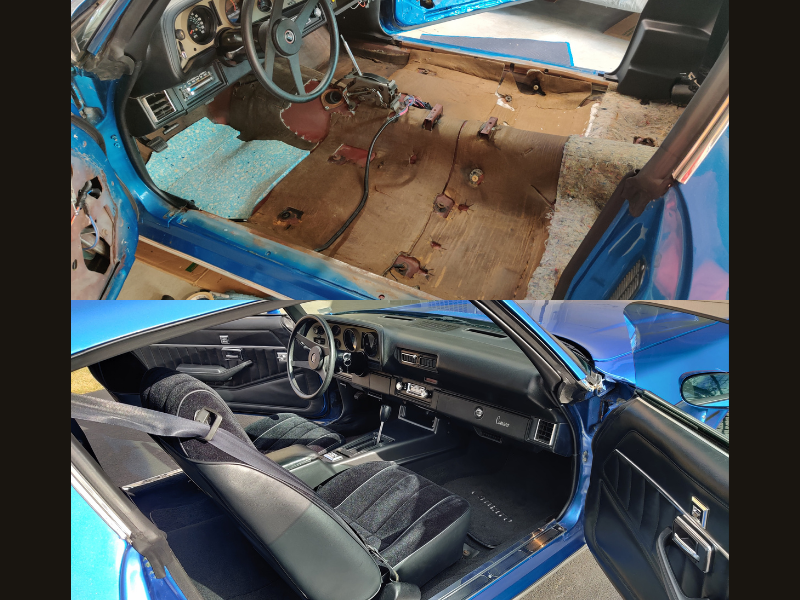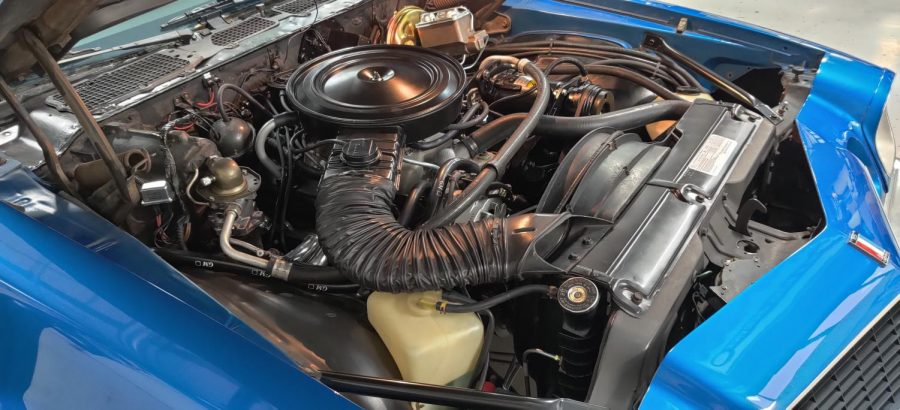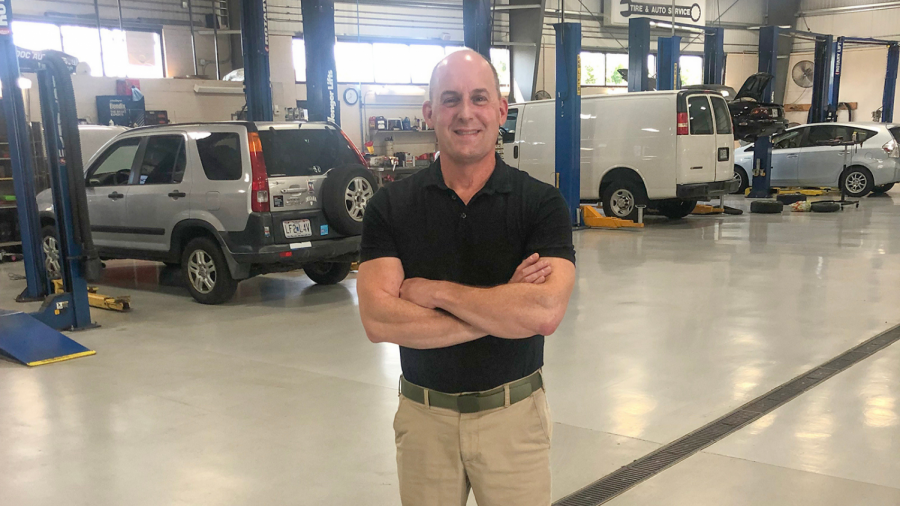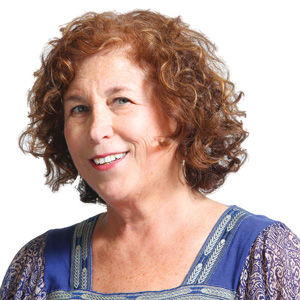How Mark Schenberg’s love affair with a ’76 Camaro fueled his career
Mark Schenberg in his automotive repair shop, Car-Doc, located in Maryland Heights. Note the tidiness and immaculate floors.
Published October 8, 2021
Life seemed to be falling into place for Mark Schenberg in the summer of 1991.
Then in his mid-20s, he was hunting for his first house in Creve Coeur. His auto repair business run from his parents’ garage had taken off, so much so that he had opened his own shop. And to top it all off, he was dating the woman he would marry.
“I had a lot of expenses on my plate at the time,” Schenberg said about that summer. “I wanted to buy an engagement ring, and I was buying a house. And I had the car sitting outside my folk’s house, with no place to put it.”
ADVERTISEMENT
The car he referred to wasn’t just any car. It was Schenberg’s baby, his first love. He bought the ’76 Camaro in 1981, when he was a junior at Parkway Central High, using $2,300 in savings to pay for it.
“This was not an extremely rare or valuable car, but it was my car,” Schenberg said, adding that his grandpa had accompanied him to buy it. “It was this ugly maroon — rusty and rough — but it’s what I could afford. In high school, if you had a Camaro or Trans Am or Firebird, you had a sports car and that was cool.
“Out of necessity, I learned that if things break on it, if it goes bad, I’d have to figure out how to fix it.”
And fix it he did — “From the day I got the car, it was all-consuming of my time,” he said — until that fateful summer when he sold it to an engineer working at KSD radio. By then, Schenberg had rebuilt the Camaro from scratch as time and money would allow and painted the exterior “GM medium metallic blue,” which looks an awful lot like royal blue.
ADVERTISEMENT
Soon after, the new owner, whose first name was Dave, moved to Cape Girardeau and drove the Camaro with him. That was the last Schenberg saw of the car … until about a year ago.

To fully appreciate this story, you need to know more about Schenberg and his passion for cars and figuring out how best to make them perform well. He grew up in a do-it-yourself household in suburban Creve Coeur, where if you didn’t know how to fix something, you made it your business to figure it out. It didn’t matter that his dad sold insurance for a living. If something broke, Earl Schenberg did his best to repair it.
“Growing up, we were taught that you don’t bring a professional into your house to do something, you do it yourself,” said David Schenberg, Mark’s younger brother. “We learned a lot of curse words from Dad under the sink when he was trying to do plumbing and would get sprayed by water and realize maybe he should have called a plumber.”
What you also should know about Mark Schenberg is that he could have been the poster child for why everyone doesn’t belong in college, although that realization didn’t come easy, especially to his father.
“My older brother Gene went to Mizzou, therefore that was the path I was going to take,” said Schenberg, 56, who is married with two adult children and belongs to Congregation Shaare Emeth. “I went to Mizzou for one semester, but I didn’t want to be there. I wanted to be in automotive.”
After leaving Mizzou on academic probation, Schenberg enrolled, at his parent’s urging, at St. Louis Community College-Meramec.
“I hated it,” he said without missing a beat.
Eventually, he found his way to the two-year automotive program at St. Louis Community College-Forest Park.
“I went down there with my mother because my dad refused to have anything to do with it then,” Schenberg recalled. “His comment was that automobiles are a hobby, and you need a professional career — then you can afford a hobby. He was adamant about it. My mom realized there might be a future (for me) there and it was what I wanted to do.”
While Schenberg entered Forest Park with an impressive amount of automotive knowledge, he also knew he had a lot more to learn. After graduating from the program, he took a job as a service adviser at Reuther Jeep. But he wasn’t doing what he really enjoyed. The job lasted about a year.
“I had been moonlighting at my folks’ house while I was still in school, working on cars and developing a client base,” he said. “From the point that I came home from Mizzou, I had people coming to me to fix their cars. My mom and dad had extra space in their garage, and the deal was as long as I fixed their cars, I could have use of their garage.”
As his customer base grew, mostly from word-of-mouth, Schenberg knew he needed a bigger space. After another year of working out of his parents’ garage, he moved his one-man automotive business, which he named Car-Doc, to a larger space he rented in Maryland Heights (11738 Administration Dr.) in 1989.
Over the next 25 years, the business greatly expanded. Car-Doc now has 12 employees who work in a 12,000-square-foot building Schenberg bought in 2015. It’s located four doors down from his original shop.
And though I know nothing about fixing cars or the automotive repair business, I have never seen a shop of this sort as immaculate as Schenberg’s Car-Doc. As my mother was known to say, you could eat off the floors.
But don’t take my word. Listen to Schenberg’s mother, Judy:
“When Mark started working out of our garage, I told him from the get-go, you get one drop of grease on the carpeting and you’re out of business,” she said. “And you know what? He never did. Since then, he’s been something of a neatnik.”

Fast forward to about 10 years ago, when Schenberg got a wild hair to see if Dave still owned the ’76 Camaro; after all, it had been 20 years since he sold it. Through Googling and by searching social media, he finally found Dave and messaged him. Turns out he had sold the car to his neighbor a year earlier, but he gave Schenberg the guy’s name and number.
“I called the guy and I think it kind of creeped him out,” said Schenberg. “I explained that I was the guy Dave bought the Camaro from and that if he ever decided to sell it, I would be interested in buying it back.
“He all but hung up on me. In fairness, he didn’t know me. He could have thought it was a scam.”
Then, suddenly, a couple of years later, Schenberg got a call from the guy, whose name was James. Seems someone had damaged the Camaro and James wanted to know the precise color Schenberg had painted it all those years ago. So he told him.
“Then, the phone rings six months later. And (James) wants me to tell him all about the engine. He wants to hop it up and put a blower on it.”
To Schenberg, this was tantamount to someone smothering prime sirloin with ketchup.
“I told him the car wasn’t built for that kind of stuff,” he said. “It’s not a race car and you’ll damage it.”
He also told James that whatever money he had in the car, Schenberg would offer double to buy it back before he messes it up.
“I said I’m the only guy who will ever do this because it’s sentimental to me. But if he was going to hop it up, I wasn’t interested. I wouldn’t bother him ever again,” Schenberg said.
While talking to a friend about what transpired, the friend suggested Schenberg buy a hot rod and trade that car for the Camaro.
“He said, ‘Go find him what he wants and trade him.’ So I started poking around on eBay and ran across the perfect car for him on sale in New York,” Schenberg said. “I then called James and said, ‘Look, if you like this, I will bid on it and bring it to St. Louis.’ ”
Bet you can guess what happened next.
Schenberg got his baby, his ’76 Camaro, back in July 2020. He spent much of the pandemic restoring it to better than what it was after he first rebuilt it more than 35 years ago.
“I realized I wasn’t near as good a mechanic as I thought I was at 16,” he said. “I completely rebuilt the car once I got it back. To be honest, I’ve put more money into it than it will ever be worth. But it’s got deep emotional roots for me.”
Today, Schenberg keeps the Camaro in the garage at his home in Chesterfield. He says it gets driven fairly regularly.

In fact, he picked up his mother in the Camaro on July 4 so they could visit his father’s grave on the anniversary of his death. Earl Schenberg passed away July 4, 2017.
“My dad became my biggest supporter, salesman and cheerleader as time went on,” Schenberg said. “Eventually, he kvelled over everything the business had become, despite being shortsighted early on.”

















